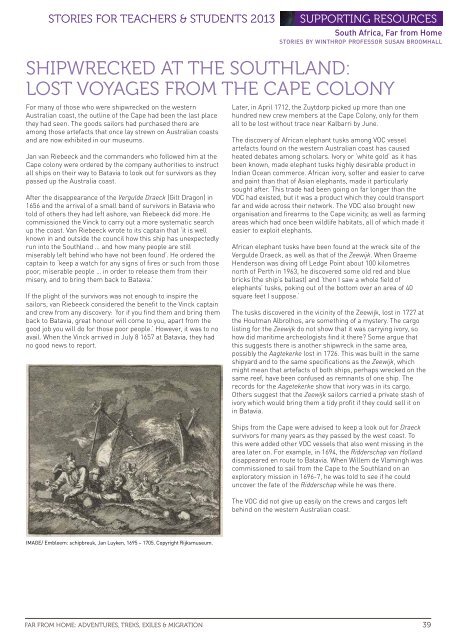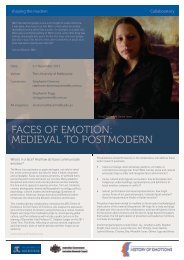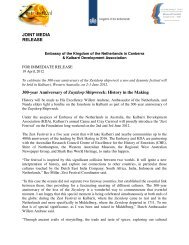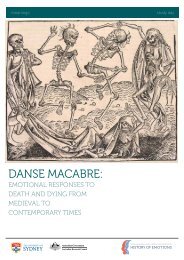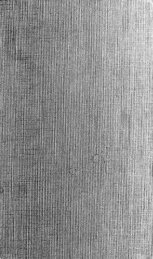Download our K-12 education pack - ARC Centre of Excellence for ...
Download our K-12 education pack - ARC Centre of Excellence for ...
Download our K-12 education pack - ARC Centre of Excellence for ...
You also want an ePaper? Increase the reach of your titles
YUMPU automatically turns print PDFs into web optimized ePapers that Google loves.
stories <strong>for</strong> teachers & students 2013<br />
Supporting Res<strong>our</strong>ces<br />
South Africa, Far from Home<br />
stories by winthrop pr<strong>of</strong>essor susan broomhall<br />
Shipwrecked at the Southland:<br />
Lost voyages from the Cape Colony<br />
For many <strong>of</strong> those who were shipwrecked on the western<br />
Australian coast, the outline <strong>of</strong> the Cape had been the last place<br />
they had seen. The goods sailors had purchased there are<br />
among those artefacts that once lay strewn on Australian coasts<br />
and are now exhibited in <strong>our</strong> museums.<br />
Jan van Riebeeck and the commanders who followed him at the<br />
Cape colony were ordered by the company authorities to instruct<br />
all ships on their way to Batavia to look out <strong>for</strong> survivors as they<br />
passed up the Australia coast.<br />
After the disappearance <strong>of</strong> the Vergulde Draeck (Gilt Dragon) in<br />
1656 and the arrival <strong>of</strong> a small band <strong>of</strong> survivors in Batavia who<br />
told <strong>of</strong> others they had left ashore, van Riebeeck did more. He<br />
commissioned the Vinck to carry out a more systematic search<br />
up the coast. Van Riebeeck wrote to its captain that ‘it is well<br />
known in and outside the council how this ship has unexpectedly<br />
run into the Southland … and how many people are still<br />
miserably left behind who have not been found’. He ordered the<br />
captain to ‘keep a watch <strong>for</strong> any signs <strong>of</strong> fires or such from those<br />
poor, miserable people … in order to release them from their<br />
misery, and to bring them back to Batavia.’<br />
If the plight <strong>of</strong> the survivors was not enough to inspire the<br />
sailors, van Riebeeck considered the benefit to the Vinck captain<br />
and crew from any discovery: ‘<strong>for</strong> if you find them and bring them<br />
back to Batavia, great hon<strong>our</strong> will come to you, apart from the<br />
good job you will do <strong>for</strong> those poor people.’ However, it was to no<br />
avail. When the Vinck arrived in July 8 1657 at Batavia, they had<br />
no good news to report.<br />
Later, in April 17<strong>12</strong>, the Zuytdorp picked up more than one<br />
hundred new crew members at the Cape Colony, only <strong>for</strong> them<br />
all to be lost without trace near Kalbarri by June.<br />
The discovery <strong>of</strong> African elephant tusks among VOC vessel<br />
artefacts found on the western Australian coast has caused<br />
heated debates among scholars. Ivory or ‘white gold’ as it has<br />
been known, made elephant tusks highly desirable product in<br />
Indian Ocean commerce. African ivory, s<strong>of</strong>ter and easier to carve<br />
and paint than that <strong>of</strong> Asian elephants, made it particularly<br />
sought after. This trade had been going on far longer than the<br />
VOC had existed, but it was a product which they could transport<br />
far and wide across their network. The VOC also brought new<br />
organisation and firearms to the Cape vicinity, as well as farming<br />
areas which had once been wildlife habitats, all <strong>of</strong> which made it<br />
easier to exploit elephants.<br />
African elephant tusks have been found at the wreck site <strong>of</strong> the<br />
Vergulde Draeck, as well as that <strong>of</strong> the Zeewijk. When Graeme<br />
Henderson was diving <strong>of</strong>f Ledge Point about 100 kilometres<br />
north <strong>of</strong> Perth in 1963, he discovered some old red and blue<br />
bricks (the ship’s ballast) and ‘then I saw a whole field <strong>of</strong><br />
elephants’ tusks, poking out <strong>of</strong> the bottom over an area <strong>of</strong> 40<br />
square feet I suppose.’<br />
The tusks discovered in the vicinity <strong>of</strong> the Zeewijk, lost in 1727 at<br />
the Houtman Albrolhos, are something <strong>of</strong> a mystery. The cargo<br />
listing <strong>for</strong> the Zeewijk do not show that it was carrying ivory, so<br />
how did maritime archeologists find it there Some argue that<br />
this suggests there is another shipwreck in the same area,<br />
possibly the Aagtekerke lost in 1726. This was built in the same<br />
shipyard and to the same specifications as the Zeewijk, which<br />
might mean that artefacts <strong>of</strong> both ships, perhaps wrecked on the<br />
same reef, have been confused as remnants <strong>of</strong> one ship. The<br />
records <strong>for</strong> the Aagetekerke show that ivory was in its cargo.<br />
Others suggest that the Zeewijk sailors carried a private stash <strong>of</strong><br />
ivory which would bring them a tidy pr<strong>of</strong>it if they could sell it on<br />
in Batavia.<br />
Ships from the Cape were advised to keep a look out <strong>for</strong> Draeck<br />
survivors <strong>for</strong> many years as they passed by the west coast. To<br />
this were added other VOC vessels that also went missing in the<br />
area later on. For example, in 1694, the Ridderschap van Holland<br />
disappeared en route to Batavia. When Willem de Vlamingh was<br />
commissioned to sail from the Cape to the Southland on an<br />
exploratory mission in 1696-7, he was told to see if he could<br />
uncover the fate <strong>of</strong> the Ridderschap while he was there.<br />
The VOC did not give up easily on the crews and cargos left<br />
behind on the western Australian coast.<br />
IMAGE/ Embleem: schipbreuk, Jan Luyken, 1695 – 1705. Copyright Rijksmuseum.<br />
FAR FROM HOME: ADVENTURES, TREKS, EXILES & MIGRATION<br />
39


